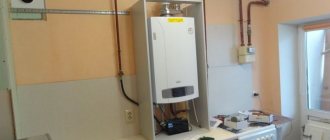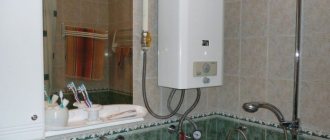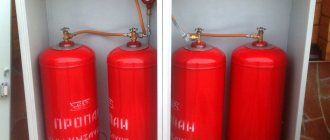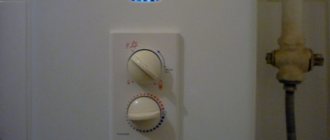Natural gas and water heaters
Today the concept of natural gas is very fashionable. What is its fundamental difference, and what did we use before? What are all these pipes for, if in the courtyards of many houses there are storage facilities with the inscription Propane-Butane, fenced with chain-link mesh. We understand that there is gas inside in the liquid phase, the calorific value of which is much higher than natural gas. This is practically the same liquefied cylinder, only in a larger volume. It is supplied to homes through reducers, which bring the pressure to the desired level. So it turns out to be main gas. (See also: How to properly install a gas boiler with your own hands)
Natural blue fuel is also not always the same. We are used to identifying this term with methane. Actually this is not true. Rather, methane is the basis (up to 98%), and the higher its specific content, the lower the calorific value of the fuel. This is why gas from different fields has different quality. In particular, a distinction is made between low-calorie and high-calorie blue fuel. Its calorific value varies greatly. Do you know what kind of gas flows through the pipes in the house? According to our calculations, the following is obtained:
- The calorific value of typical natural gas is about 32 MJ/cubic meter. How many degrees can such a volume raise the temperature of a ton of water? The specific heat capacity of the most common liquid on the planet is 4200 J/kg ºС. Let's calculate: t = E / Vc = 32 MJ / (1000 x 4200) = 7.6 ºС, this is how much the temperature of a cubic meter will increase.
- The cost of gas in homes usually fluctuates around 60 rubles and depends on the region. But it's not always natural gas. We're not sure if the calorific value is correct because the containers in the yard usually say Propane-Butane. They can have up to twice the calorific value. Natural gas can cost about 4.5 rubles per cubic meter, and this radically changes the balance of power. If the house is supplied with liquid propane-butane, then less is spent, and the calorific value is two to three times higher (up to 110 MJ/cubic meter). Thus the calculation problem is not trivial.
- However, we will tell you what to do. Data on the gas pressure in the line and its calorific value can be requested from service 04. This is done by any master who intelligently configures the device for a new type of gas. Therefore, if desired, everyone can clarify the calculation to suit their own conditions. Based on this information, we can say that homes that already have natural gas installed will actually benefit from its use. This will happen several times. However, you will have to worry about removing combustion products yourself.
- According to SNiP recommendations, the pipe should be located above the roof level. In rare cases, it is allowed to move outside the outer wall if this can be agreed upon with government organizations. In private homes, a coax with a protective grille is often used, which goes directly outside from the boiler or convector, but this is not entirely correct. As a result of combustion, sulfuric acid is formed, which will gradually harm the house. However, owners of private houses where natural gas is available can take note of the method. Just in case, we emphasize again! You should not make a homemade gas water heater. It is illegal. You don’t even have the right to install a gas water heater yourself.
(See also: How to properly install a water heater)
- As for electricity, 60 rubles can buy about 16.8 kWh. Let's try to convert this into units so that we can compare it with gas. Ordinary physics will help with this, from which it is known that power is work per unit time: A = Nt = 16.8 kW x 3600 s = 60.48 MJ.
- It turns out that electricity is more profitable than natural gas, which costs 60 rubles per cubic meter. There is no danger of flying up into the air. The advantage of gas is that its combustion rate is such that it develops a power much greater than that of an electric heating element. For example, 15 kW is not at all the limit for speakers and boilers, but rather a certain initial level. It is simply impossible to install an electric water heater of such power at home. The quota for Khrushchev is about 5 kW. This should be understood and used wisely.
(See also: How to install a boiler with your own hands)
Please note that bottled gas has a lower cost in specific terms than residential propane-butane. There are more problems with it: you need to buy cylinders, reducers, hoses, and connect at least two tanks in parallel. The removal of combustion products is a separate topic of conversation. As a result of chemical reactions, not only carbon dioxide and water vapor are produced, but also sulfur oxide. All this combined produces an explosive mixture. That is why it is impossible not only to bring such an army into ventilation, but even to modify special chimneys with anti-corrosion steel or ceramics. It costs money, a lot of it. Attempts to save money will ultimately harm the house, neighbors, and the owners themselves.
A gas or electric water heater is selected based on all of the above considerations. The economic effect of the purchase is assessed. A gas water heater can quickly recoup its own cost if it runs on cylinders or natural gas, and there is a place to supply combustion products. In this case, it is recommended to think about this if the house already has a boiler that operates using blue fuel. Otherwise, installing gas in some village may cost about 70,000 rubles. Calculate how many years this will last to use electricity based on your own needs. Again, a domestic gas water heater must be purchased, nothing else. (See also: How to install a water heater with your own hands)
And here's another thing! Do not forget that the efficiency of electrical appliances reaches 98.5%, while gas appliances often emit combustion products with temperatures of 100 ºС and above. This must be taken into account in the calculations. By all indications, the cheap source of energy presented in the YouTube video may not be so free. It’s another matter if there is no meter in the apartment, and the payment is based on a certain quota. This is the choice of poor families, and the energy will indeed be wasted. In this light, there is some sense in inventing something.
Advantages and disadvantages
Pros:
- Safety.
- Long service life.
- Easy to maintain.
- Economical.
Minuses:
- There is no possibility of heating water (single-circuit models).
- Stopping heating during water supply (double-circuit products).
- Expensive installation.
- A chimney is required.
- Sufficient gas and water pressure.
Selection criteria for a private house/apartment:
- Manufacturer's brand.
- Price.
- Power.
- Ignition type.
- Burner type.
- Method for removing combustion products.
- Safety.
- Installation method.
- Number of circuits.
- Type of fuel.
- Material.
Consumers are particularly scrupulous about cost. Sometimes a product with lower prices may turn out to be of high quality with excellent characteristics.
The law - what the drawbar is, where it is turned... that’s where it came out
The design on YouTube is not illegal, but it is not very convenient. There is even less chance of setting it up correctly for use. Here are a couple of tips to help you do this somehow:
- The radiator in the video resembles something from a car hood. There was no time to figure out what exactly it was, but the point is that you will need not just a coil, but just such a corrugated surface. This will significantly increase the efficiency of the device, on which both efficiency and gas fees (if there is a meter) ultimately depend.
- This device is a gas instantaneous water heater, which should produce about 4 liters of warm water per minute. It’s easy to calculate how much power it should have for this:
(See also: Do-it-yourself instantaneous electric water heater)
- N = A / t = (4200 x 4 (45 - 8)) / 60 = 10.36 kW, this is the power achievable for a factory gas water heater. You can only find out if you can make an appropriate heat exchanger at home by trying it.
The device itself is a coil, which is connected at one end to a cold riser, and at the other to a shower head or mixer. The flow is regulated by a valve. In this sense, you will have to use an old cast-iron tap at the inlet or a bronze tap at the outlet of the coil. The radiator is placed on the hob grate and heated by one or two burners. It is clear that the hose must be heat-resistant, otherwise various unpleasant consequences are possible.
An adult must supervise the operation of the device and, in case of danger, turn off the supply of blue fuel while someone is washing or doing the dishes. A gas water heater or an electric water heater is much safer from this point of view. I would also like to add that even purchased equipment needs to be configured, which means that the intervention of a qualified technician will be required. Sometimes a set of jets (injectors) needs to be replaced, in other cases a reducer is installed in the gas supply path. In the latter case, the system resembles traditional propane-butane power supply.
Power, type of ignition and burner
The most important parameter of the device is power. It is this that determines the minimum energy costs and the future comfort of housing. You can calculate it yourself, taking into account that with an area of 10 sq. m and a ceiling height of 3 meters, one kilowatt of power will be required.
There are several ignition options: hydraulic turbine, electric and piezo ignition.
The first type (turbogenerator) is widely used in expensive modifications. As soon as the hot water tap opens, the burner automatically ignites. The high cost is the only disadvantage of the device.
Electric ignition also occurs when the hot water tap is opened. In order for the device to function, it must be provided with a power supply (batteries), which must be changed periodically.
Main types
In addition to single-circuit and double-circuit column boilers. There are also models with natural draft and with a closed combustion chamber. The first type during operation uses a chimney, which must be present in the room. In products of the second type, combustion products are removed using a fan, for which you can use the general ventilation systems of apartment and private houses. Therefore, such boilers are widespread not only in private doses, but in multi-storey buildings. The water-indicating boiler column maintains the optimal water level. Also, models not only with the flow-through principle of heating water, but also with a built-in battery are actively promoted in our market. Condensing boilers have a high percentage of efficiency and, at the same time, guarantee economical operation even at high power levels.
What you need to remember when working with a gas water heater
Before installing the equipment, you must adhere to the following rules:
- Checking the ventilation operation - installation is allowed in rooms with an exhaust hood (bathroom or kitchen). The water heater must not have access to air blocked; without it, it cannot turn on/ignite and operate normally.
- You cannot install the equipment near flammable objects - it is prohibited to install it above gas stoves.
- The device must not be covered with tiles, bricks or panels - they will interfere with inspection and testing. If a problem occurs, it will be difficult to detect, and delay will lead to disastrous results.
The gas water heater is hidden using decorative doors.
Before any repair work or attempts to hide the water heater, you need to study the requirements of the local gas service. Carrying it yourself, creating blind boxes and covering it with panels may result in a fine and will require a fresh refurbishment in accordance with established rules.
Advantages and disadvantages
The advantages of this equipment include:
- compact size;
- quiet operation;
- neat appearance.
There are also disadvantages, among which it is worth noting:
- complex device, which may cause some difficulties in case of breakdown;
- short service life.
DIY boiler
To assemble a boiler with your own hands, you need to understand that you are taking on great responsibility as this process is unsafe. First, you will need a diagram in which each stage will be described in detail, then you need to calculate and prepare all the necessary parts for manufacturing.
IMPORTANT! The gas service does not approve of the installation of homemade equipment as it is contrary to the law.
From the geyser
A gas boiler can be made from a gas water heater. With its help you can heat a small room, such as a bathhouse. The column has high productivity, so it consumes a lot of natural gas. For this equipment, you will need to reduce the consumption of this substance by installing 2 gas burners made in China, making a hole in the nozzles measuring 1 mm. Instead of an expansion tank, a plastic tank or gas cylinder is often used. It is installed on the supply line so that no vacuum is created during pump operation. The pump is used new or taken from an old washing machine, the control unit is installed without a timer.
From a gas stove
A metal tank filled with water is installed on the heating burner, which is connected to a pipeline made of plastic through the top. A pump is connected to the container below, with the help of which water is supplied to the batteries.
To make the device safe, an expansion tank is installed; a small gas cylinder is suitable for this. A safety valve is also installed to prevent all sorts of obstacles to the supply of electricity to it.
Such heating equipment will not have enough power to heat an apartment or house during frosts, but it is well suited for heating in the autumn or spring.
How to hide a gas water heater in the kitchen
Aesthetics should not take precedence over safety rules. When solving the dilemma of how best to hide a water heater in the kitchen, you need to avoid falling under restrictions from the gas service.
Is it possible to hide a gas water heater in a closet?
This approach is considered the best, but is not always legal. Covering the device in certain areas is completely prohibited. To avoid problems, you need to obtain official permission from the local gas service, they will also answer all your questions about the problem.
Speaker in a cabinet with a patterned door in the kitchen
Transfer to the corridor
Changing the initial location of the device always requires permission from the gas service. Permits can be obtained if the following requirements are met:
- ceiling height in the hallway – 2 m 25 cm;
- from the equipment to the second wall – 1 m;
- There must be ventilation above the device - with a diameter of 12.5 cm.
In exceptional cases, the water dispenser can be moved to the bathroom - with the consent of gas inspection representatives.
Closing with a kitchen unit or panel
Many people are interested in whether it is possible to cover a gas water heater with the facade of the kitchen. You should know that a solid structure to hide an apparatus with an open combustion chamber is not allowed. Front and side panels are permitted, and the cabinet itself must be larger than the volume of the water heater.
Hiding a gas water heater behind the kitchen façade is a violation of safety requirements and faces real fines.
Placement between pieces of furniture
Refers to practical options. If the color of the device and the walls match, it will be difficult to notice. The only requirement is that there must be a certain distance between the unit itself and the furniture.
The unit can be left freely accessible or covered with a false door that matches the parameters of the kitchen units. It is fixed to adjacent modules, and holes are made in it for free ventilation.
Placement between lockers
Removable cover
It is made of non-flammable material and is maintained in the general style of the room. It should not close at the top and bottom to ensure adequate air flow.
Blind structures can cause a fire due to heating of the material from the surface of the chimney.
Placing the device in a corner
With this arrangement, the equipment will be noticeable only in certain cases, especially if it does not stand out against the background of the headset and walls. The column can be placed at the end or hidden behind a corner cabinet made according to the requirements of the gas service.
Installing the device in a corner
The most undesirable option of all is the use of PVC panels to mask the gas water heater.
Installation of a column boiler
A gas boiler uses a burner to heat water, which is supplied to the heating circuit by a pump. The main characteristics of such a product are the power and volume of water required for the operation of the system. Accordingly, the larger the area that needs to be heated, the greater the power of the corresponding equipment must be. The main advantage of modern products is reliability. Safety systems, including ionization control, allow boilers to be operated with maximum benefit and minimal risk of malfunctions and possible damage.
Installation of the boiler must be coordinated with the gas service. The wall-mounted boiler is attached to the wall using large self-tapping screws. The wiring is mounted below. The cold water pipe must be equipped with thermal insulation to prevent the formation of condensation. To protect against scale, it is best to use a magnetic transducer, which is placed at the input of the column. The long service life of such a device guarantees comfort in using the boiler. To connect gas, you need to purchase a special hose, and to relieve pressure in the system, you need to purchase a safety valve. The final step is connecting the boiler to the electrical network.
Features of arranging electric and infrared floors
Electric heated floors are also often used in the bathroom if there is a need to lay tiles. So, in this case, the process involves the following sequence of work:
- Pouring a rough screed, which is used to level the base.
- Laying thermal insulation material with a reflective layer.
- Installation of reinforcing mesh. This is where the cable will be attached.
- Installation of heating cable. Please note that metal clamps should not be used to secure it. The cable must be laid out exactly according to the previously drawn diagram.
- Installation of thermostat. Please note that it should be located at a height of about 0.8-1 m from the floor.
- Test run of the system. At this stage, the resistance of the structure is checked. If possible, it is necessary to find the areas where the short circuit occurs. If they are not there, you can continue working.
- Filling the screed. In this case, its thickness is at least 5 cm.
- Additional functionality check. That is, you again need to measure the resistance in the system.
Should not have voids. In addition, it should be reinforced with fiberglass. Only in this case will you be able to avoid its subsequent destruction under the influence of temperature changes.
Installs the fastest. Its distinctive feature is the absence of the need to arrange a screed. That is, the tiles can be laid directly on the film. Such a warm floor just needs to be laid out according to the diagram. It must be taken into account that the heating elements should not end up under heavy pieces of furniture. Otherwise, local overheating will occur and the heated floor will fail.
It is important to connect and insulate the infrared system correctly. You should also take care of the correct installation of the sensor and thermostat
After checking the functionality of the structure, you can lay the tiles.
That's all the features of arranging heated floors in the bathroom. Be careful during installation. Leave your comments on the article and finally, a video about the technology of laying heating mats:
In recent years, floor heating technology has become popular in ordinary city apartments. Underfloor heating from a heated towel rail is a budget option for a heating device, which is used in cases where installing a boiler is impossible for some reason.
The connection diagram for a heated towel rail to a central heating system has a number of variations; it is from the existing diagram that you need to start from during installation. In some apartment buildings, heated towel rails are powered from the “return” of the heating system. This option implies a fairly low temperature in the riser and heated towel rail, and in the summer, during periods when the heating is turned off, the pipe cools down completely. It is better to abandon the idea of installation in such houses; the system will not function correctly.
Another option is to power the heated towel rail from hot water in the bathroom. In this case, the heating circuit will work much more efficiently, but you need to correctly calculate the cross-section of the pipe, measure the area and correctly connect the water floor itself. The metal-plastic pipe should be smaller in diameter than the riser; most often the best option is D16. A water floor requires special attention during installation, especially if you do the installation yourself.
The methods for connecting a heated floor with your own hands are quite simple; through the main hot water riser, an additional connection is made to the contour of the heated floor. The pipe goes into the floor and returns to the heated towel rail. An adjustment tap is cut into the riser, which can be used to dose the supply of hot water through the riser directly. The main flow is assumed to be through the floor contour in the room.
The floor pipe is mounted on a substrate; the bend radii must be minimal so that the flow resistance is not critical. Such a bathroom floor will only work if there is good pressure in the pipes.
To connect several underfloor heating circuits to a hot water supply system, a manifold is used, through which you can regulate the supply of hot water to each circuit separately, sometimes the system is supplemented with a pump for circulation, but such options can only be cost-effective in large apartments and used in more than one room.
- economical to use;
- durability when installed correctly.










